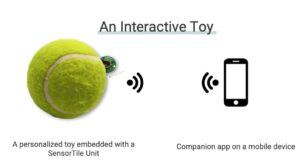Last fall, Harvard Extension School held its first course ever around our SensorTile (STEVAL-STLKT01V1) platform, Introduction to Wearable Devices and Sensor Data (DGMD E-13), and we sat down with its instructor, Jose Luis Ramirez Herran, as well as two of his students, Joanna Gammel and Jal Panchal, to learn more about their experience.
[pretty-callout align=”right”]Fun Facts
- The foundation for this course (Introduction to Embedded Systems with SensorTile) is available for free and open to all.
- Capstone projects from UCLA students using SensorTile are available online.
Jose Luis Ramirez Herran or the Art of Making Embedded Systems Relevant Today
Introduction to Wearable Devices and Sensor Data integrated the undergraduate class Introduction to Embedded Systems with SensorTile developed by Professor William Kaiser at UCLA but adapted it to students currently working on a Masters degree. It was thus fascinating to see that both coursework offer the same life lessons that come from learning embedded systems with the SensorTile, and both can speak to students at different stages of their education to ensure that they get the skills they will need to face the industry’s latest challenges. As Mr. Ramirez Herran explained:
“It was crucial to ensure continuity between this course and the other requirements of the Master of Digital Media Design. We didn’t impose specific prerequisites in programming, mathematics, or machine learning. We wanted to focus on helping creative students express their ideas through an accessible prototype, which is why the SensorTile attracted me very much.”By relying on ST’s IDE and firmware, among others, Mr. Ramirez Herran was able to spend more time focusing on creating relevant coursework. Development took about a year; it involved faculty and students and ensured that the notions taught would easily apply to all sorts of applications. Indeed, as the students’ projects showed, the course enabled them to take concepts from a wide range of disciplines and bring them to life in a prototype that leverages the SensorTile’s sensors and development tools. The initiative was so successful that Mr. Ramirez Herran will offer a similar class, both on campus and online, this summer, with an additional chapter on computer vision (Wearable Devices and Computer Vision, DGMD S-14) . The university is also evaluating the possibility of giving a class on embedded systems with SensorTile to its undergraduate students working on a computer science degree.
Joanna Gammel and Christopher Hansen or Looking at Music Through SensorTile

Joanna Gammel and Christopher Hansen attended Mr. Ramirez Herran’s class and worked on a project that rests on synesthesia, the phenomenon in which a sensory sensation triggers another sensory reaction, such as when we associated numbers or letters with a color or a smell. In this case, they were using the microphone of the SensorTile board, streaming audio to a BeagleBone using Bluetooth, and applying a fast Fourier transform algorithm, to translate sounds into colors. They were envisioning applications in the entertainment industry or helping people with a hearing impairment experience music. This project also shows the impact that a class around SensorTile can have on students. As Joanna told us:
“The coursework and classes led the students to learn more about the broader applications of sensors and their inner workings, as well as the latest breakthroughs in technology, or psychology, and how IoT already contributes to these disciplines.”Joanna and Christopher do not come from an engineering background, and they had no substantial knowledge in C or embedded systems. However, they were able to leverage the SensorTile’s flexibility to make it work for them. By using Socket.IO and Johnny-Five, they were able to write their application partly in JavaScript with Node.JS, and thus use their experience in web development. Joanna also explained that she and Christopher faced challenges in capturing the audio clips that they would turn into colors. However, the support from Mr. Ramirez Herran and a private community composed of faculty and students from another university, as well as our engineers, helped them work past it and enabled them to come up with a working proof-of-concept. Prototyping with SensorTile gave them the skills they needed to tackle the next IoT projects that will come their way.
Jal Panchal or the Smart Ball that Brings Joy to Children with Cerebral Palsy

Jal Panchal presented an impressive project in the form of a smart ball that tracks the movements of children with cerebral palsy to help with their physiotherapy. As a person suffering from this disorder, he understands better than anyone how difficult it is for children to find the motivation to practice the exercises they learn with a physiotherapist. Additionally, the absence of professional supervision at home means that it is easy to take on bad habits. By inserting a SensorTile module in a ball, Jal was able to track a child’s movements and offer feedback through a mobile app, thus turning a therapy session into a game. It also gives a monitoring platform to physiotherapists who can work with reliable and precise data to better assist their patients.
Jal was already familiar with Arduino boards and Raspberry Pi systems when he took Mr. Ramirez Herran’s course and had an interesting comment:
“I’ve been playing with IoT boards for quite some time, and SensorTile was a real surprise because it feels like a hobbyist’s platform, but it has the capabilities of an industrial-grade system. Collecting data is relatively straightforward, and yet we have access to a full-blown microcontroller and powerful sensors, which means that I can build a full-fledged application on the same module that serves as my proof-of-concept.”As he explained, the course offered a smooth and gradual transition from his experience as a hobbyist to industrial applications. SensorTile works for undergraduate and graduate students and the access to the Flash, RAM, I2C protocols, and the STBLESensor mobile application enables them to quickly work on the relationship between sensors, the cloud, and a smartphone, to better grasp the meaning of IoT.
What Will You Create?
- Learn more about Jose Luis Ramirez Herran and the courses he teaches at Harvard
- Check out the SensorTile Curriculum: Introduction to Embedded Systems
- Get a SensorTile STEVAL-STLKT01V1 development kit
